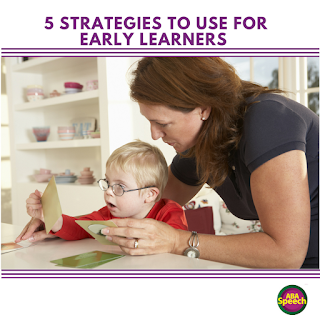Working with early learners with autism and other complex communication disorders can be such a rewarding experience. It can also be quite overwhelming. I wanted to share with you today the 5 five strategies I use when working with early learners who are non-verbal or limited verbally. Helping each student I work with find their voice is so very important!
1. Assess your student’s ability to request. Requesting is such a powerful function of our communication. Being able to let people know what they want throughout the day is vital to increasing our student’s ability to communicate with the world. When you are working with your student note whether they are able to independently request preferred items, places, activities, etc…
2. In conjunction with number 1, I always make a note of what items, activities, places, people, etc.. are preferred by my student. Knowing this information is so very vital in helping us determine what requests we can help our students practice throughout their therapy sessions and throughout their day. If you are working with a student who seems to have a very limited amount of preferred items, activities, places, etc…., you might want to use a preference assessment. There are very specific ways in which to gauge learner preference but a way to start with this process would be to use a preference assessment. I have linked to my favorite one here ( this can easily be read with the password you receive when signing up at www.abaspeech.org. A preference assessment can help you determine what your learner enjoys and this is important when working on requesting.
3. Another very important factor that needs to be considered is how will the learner communicate. This is very much a team based decision and requires much discussion, thought and trial. Will the student use sign, pictures, a device, verbal speech or a combination of those? This is very individualized and needs to be discussed and probed with the student. This process can be dynamic and may change over time. Sign language can be such a great place to start and it often is not accepted as people may say ” I don’t know any sign.” A great website that can make this response form easier to understand is called www.lifeprint.com. Check out my tutorial on the subject here.
4. Collaboration among team members will also be very important for our learners. We need to make sure that all team members understand that we are working on requesting. We should provide information about why we start to work on requesting, what requesting looks like for our student and how we can embed this throughout the student’s day. If you feel comfortable sharing information you have learned about requesting with the team, this would be a great time to do that. If your team needs more support in learning this information, taking my course Help Me Find My Voice is a wonderful option. There are individual and group options available.
5. Start work on requesting with your learner. Make sure that you have a good understanding of what the student may be motivated to request, how they will request these items or activities and that the team is on board with these strategies. Being on the same page and working on requesting, can help our students “find their voice.” This video below ties in all of the above concepts. It is nice to include for a staff training on this very subject.
And if you prefer to take a listen to these 5 strategies discussed, take a listen to my Facebook Live on the subject.


0 Comments